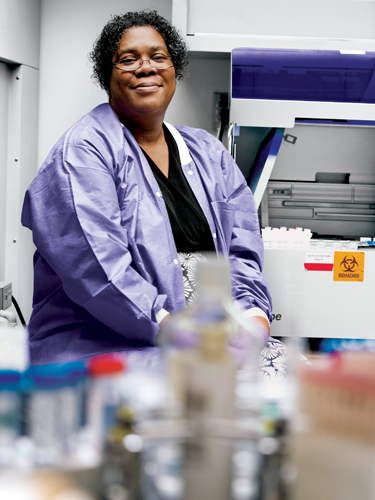Finishing School

Photo: Pete Vidal
He enrolled at Montgomery College with a 1.3 grade point average from Rockville High School and no money to pay for his education. His mother and father, only high school educated in El Salvador and Peru, respectively, could offer no help navigating the daunting college admissions and financial aid process.
“Only 10 percent of first-generation, minority background students actually complete a bachelor’s degree. In fact, when I graduated high school in 2005, the dropout rate for Hispanic students was almost double the rate of any other ethnic group,” says Hesse.
Hesse’s first stop—and last hope—after graduation was Montgomery College. He overcame abysmal grades and near expulsion from high school to complete a degree.
While he became an exceptional student, Hesse’s accomplishment has proven elusive for other students, according to data by Complete College America, a national nonprofit working with states to improve college completion. Between 1970 and 2009, undergraduate enrollment in the United States more than doubled, while the completion rate had been virtually unchanged. Once first in the world, America now ranks 10th in the percentage of young adults with a college degree.
President Barack Obama set an ambitious goal to have the highest proportion of college graduates in the world by the year 2020. To reach this goal, the US Department of Education projects that the proportion of college graduates in the United States will need to increase by 50 percent nationwide by the end of the decade.
Governor Martin O’Malley set ambitious completion goals for Maryland as well: 55 percent of Maryland’s adults, ages 25 to 64, will hold at least an associate’s degree by 2025. Maryland legislators enshrined this goal in law with the adoption of the College and Career Readiness and College Completion Act of 2013. The law calls for greater collaboration among all sectors of education from preschool to college and requires initiatives to drive completion.
Maryland State Senator Rich Madaleno, who cosponsored the college completion legislation, believes Maryland’s higher education institutions face a tough challenge: educating a different type of student with fewer resources. He suggests that if institutions don’t meet this challenge, they’ll fall behind the competition. “We can’t afford that as a state—a state so dependent on the educational ability of its citizens.” he says.
Driving that graduate increase is the need for an educated workforce to fill the jobs of the future. Complete College America found that, by 2020, more than two-thirds of the jobs in Maryland would require a career certificate or college degree.
Additionally, nearly 30 percent of Americans with associate’s degrees now make more than those with bachelor’s degrees, according to Georgetown University’s Center on Education and the Workforce. In fact, other recent research in several states shows that, on average, community college graduates right out of school make more than graduates of four-year universities.
“I had a bachelor’s degree in biology from Coppin State University,” says Kimberly White ’12. “But I needed something that was going get me into the workforce quickly.”
White, who had been out of the research field for more than 10 years, feared her skills wouldn’t be relevant in today’s innovative labs. That prompted the mother of five from Shady Side, Md., to enroll at the College in fall 2010. She planned to combine her prior course work with classes in cell culture and computer science.
Soon after she started, White, like many of her community college contemporaries, had a life crisis threaten to stop her progress. Her husband required surgery in January 2011. Dr. Collins Jones, a biotechnology professor at the College, recommended she take a class in cell function and cell structure so she could make herself more marketable.

Photo: Sanjay Suchak
“I debated whether or not to finish the degree,” says White. “In the end, it paid off in ways I never expected. I wanted to walk across that stage and show my kids I completed something. They were excited to see that aspirations and goals can be reached and accomplished.”
White’s children—and many other Maryland students with college degree ambitions—will benefit from the new college completion legislation. It enumerates a series of goals, strategies, and initiatives aimed at reducing the need for remediation and enhancing college completion. The list of expectations includes expanding access to early college, enhancing transferability, expediting the time for degree completion, and ensuring more high school students are college ready.
Every year, more than two-thirds of all Maryland community college students enroll in remediation, just like Hesse, who had to take two developmental math courses when he first arrived. Developmental courses are necessary to ensure a student’s success in college-level course work, but these add to a student’s financial burden, and they often push back a student’s anticipated completion date.
In a report released by the American Institutes for Research in 2010, of the 1.1 million students who entered college in 2002, nearly 493,000 failed to graduate within six years, causing them to earn much less than students who graduated and costing an estimated $4.5 billion in lost income and federal and state income taxes in 2010.
“I didn’t have the mindset to pursue higher education,” says John Yi, a 25-year-old Clarksburg resident, who started his odyssey at Montgomery College in 2007. “I signed up for classes because my parents wanted me to. School was my last priority.” And it showed. After failing or withdraing from almost all of his classes for nearly three years, Yi gave up and briefly stopped attending.
While working full time at Bank of America as a sales specialist, Yi finally realized, “I was living paycheck to paycheck. My friends were off doing big things—and I was pretty envious. I knew if I wanted to do better, I needed a degree.”
In 2010, he resurrected his academic career, retaking a number of classes he’d previously failed. He managed to replace Ws and Fs with As and Bs. By the end of the spring 2013 semester, he had the credits to transfer to the University of Maryland. He is currently pursing a bachelor’s degree in computer science.
Though only one class short of his AA in general studies, Yi did not pursue the degree. “To be honest, I didn’t think it was important to get an associate’s as long as I got my bachelor’s,” he says. He’s not alone: 86 percent of the College’s students fail to complete a degree in three years.
“It’s a missed opportunity,” says Dr. Donald Pearl, the College’s senior vice president of academic affairs, who extols the virtues of completion. “If you leave here with a degree, it has very clearly defined outcomes that someone in industry would be able to understand. It shows you have the broad-based educational experience to get a job. Getting the degree says you can start a job and finish it.”
To ensure even more Montgomery County students get the help they need to come prepared to College—and to complete a degree, Montgomery College, Montgomery County Public Schools, and the Universities at Shady Grove launched an innovative program for underrepresented high school students this fall. Achieving Collegiate Excellence and Success (ACES), a free program, helps students throughout their high school and MC experience with academic coaching, college readiness and success activities, and support services.

Photo: Pete Vidal
Hesse parlayed his education and experiences—good and bad— into a full-time admissions representative position at the University of Maryland. “I have a unique viewpoint,” says Hesse. “Not only is it incumbent on education to help the student with straight As and 2,400 on the SAT, but also the student who’s below average and wants to reach his or her potential. We have to make all students’ dreams come true.”
—Jill Fitzgerald
New Law Impacts K–12 Students, Too
The College and Career Readiness and College Completion Act of 2013 impacts the Maryland State Department of Education (MSDE) and local K–12 school systems, too. The key elements of the bill include:
- Providing that all students must be assessed for college readiness no later than grade 11
- Requiring the MSDE, in collaboration with local school systems and community colleges, to develop and implement transition courses or other instructional opportunities to be delivered in high school
- Requiring that all high school students must enroll in mathematics each year of high school
- Setting a goal that all secondary students achieve Algebra II competency
- Prohibiting public higher education from charging tuition to dually enrolled students
- Requiring local school systems to reimburse public higher education institutions for a portion of the tuition for dually enrolled students
This article first appeared in the fall 2013 issue of Insights.


